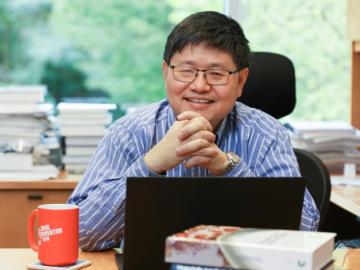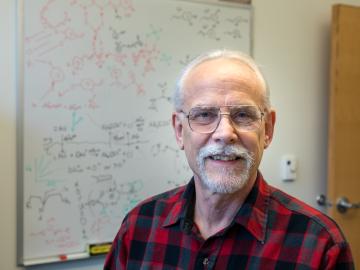
Filter News
Area of Research
- (-) Fusion Energy (6)
- (-) Materials (55)
- Advanced Manufacturing (6)
- Biological Systems (1)
- Biology and Environment (4)
- Building Technologies (1)
- Clean Energy (60)
- Climate and Environmental Systems (2)
- Computational Engineering (1)
- Computer Science (8)
- National Security (5)
- Neutron Science (23)
- Nuclear Science and Technology (11)
- Quantum information Science (3)
- Supercomputing (31)
- Transportation Systems (1)
News Topics
- 3-D Printing/Advanced Manufacturing (5)
- Advanced Reactors (4)
- Artificial Intelligence (1)
- Bioenergy (2)
- Clean Water (2)
- Composites (1)
- Computer Science (3)
- Cybersecurity (1)
- Energy Storage (4)
- Environment (5)
- Fusion (5)
- Isotopes (1)
- Materials Science (18)
- Microscopy (5)
- Molten Salt (1)
- Nanotechnology (6)
- Neutron Science (4)
- Nuclear Energy (8)
- Physics (2)
- Polymers (2)
- Quantum Science (2)
- Sustainable Energy (5)
- Transportation (5)
Media Contacts

OAK RIDGE, Tenn., May 7, 2019—Energy Secretary Rick Perry, Congressman Chuck Fleischmann and lab officials today broke ground on a multipurpose research facility that will provide state-of-the-art laboratory space

Researchers at the Department of Energy’s Oak Ridge National Laboratory, Pacific Northwest National Laboratory and Washington State University teamed up to investigate the complex dynamics of low-water liquids that challenge nuclear waste processing at federal cleanup sites.

OAK RIDGE, Tenn., May 1, 2019 – Sheng Dai, a researcher at the Department of Energy’s Oak Ridge National Laboratory, has been elected fellow of the Materials Research Society (MRS).

Ionic conduction involves the movement of ions from one location to another inside a material. The ions travel through point defects, which are irregularities in the otherwise consistent arrangement of atoms known as the crystal lattice. This sometimes sluggish process can limit the performance and efficiency of fuel cells, batteries, and other energy storage technologies.

Bruce Moyer’s career as a trailblazing chemist began with a Gilbert chemistry set, the perfect Christmas gift for an inquisitive kid growing up in 1960s Pennsylvania. Moyer squirreled away the test tubes and racks of chemicals in his bedroom to conduct unsupervised experiments on solubility, corrosion, and other subjects included in Gilbert’s captivating manual.

Kevin Field at the Department of Energy’s Oak Ridge National Laboratory synthesizes and scrutinizes materials for nuclear power systems that must perform safely and efficiently over decades of irradiation.

OAK RIDGE, Tenn., March 22, 2019 – Karren Leslie More, a researcher at the Department of Energy’s Oak Ridge National Laboratory, has been elected fellow of the Microscopy Society of America (MSA) professional organization.


OAK RIDGE, Tenn., March 1, 2019—ReactWell, LLC, has licensed a novel waste-to-fuel technology from the Department of Energy’s Oak Ridge National Laboratory to improve energy conversion methods for cleaner, more efficient oil and gas, chemical and

Vera Bocharova at the Department of Energy’s Oak Ridge National Laboratory investigates the structure and dynamics of soft materials—polymer nanocomposites, polymer electrolytes and biological macromolecules—to advance materials and technologies for energy, medicine and other applications.


